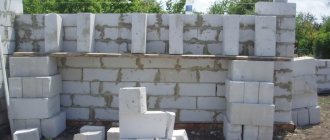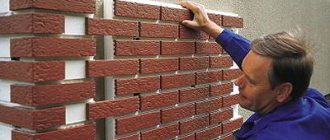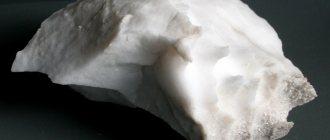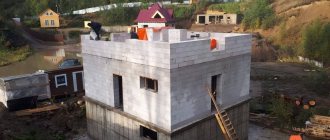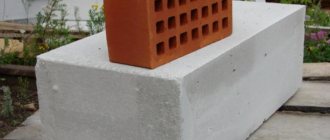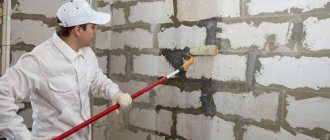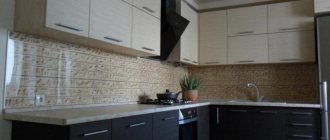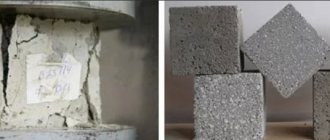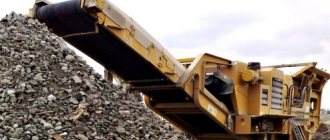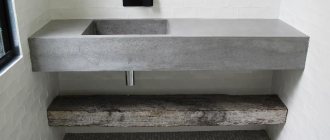When planning to build a house, it is important to immediately make the right choice of the main building material. The strength of the housing and the comfortable microclimate depend on what you will build the building from. The walls must be created from environmentally friendly raw materials, which have low sound and thermal conductivity, as well as fire-fighting properties. To make the final choice which is better, let’s compare two modern and popular materials and choose which is better – aerated concrete
or
foam concrete
.
| Foam concrete | Aerated concrete |
Reviews about aerated concrete blocks
But in general, I can only give positive feedback and a high five to aerated concrete. What attracted me was that production is carried out using imported equipment.
View full version: I'm building a house, I need help with building materials! Is anyone doing it?
This means that deviations from standard sizes are practically excluded. I read materials and opinions posted on English-language resources. Judging by them, the service life is long. By the way, with the same density as foam concrete, aerated concrete blocks are much stiffer. I have been living in my house for over 2 years now and I can imagine that it will last for many years.
For all this time, there are no complaints about the quality of the products. I am a builder myself, so I can really evaluate all the pros and cons of aerated concrete. The cost of blocks depends on their characteristics, including sizes.
Given the large range of products, it is appropriate to give only average prices for products. Consumption is approximately 1.5 times lower than for solution.
Comparison of foam concrete and aerated concrete
| Characteristic | Aerated concrete | Foam concrete |
| Coefficient of thermal conductivity | 0,084-0,147 | 0,22-0,37 |
| Brands by density | 300, 400, 500, | 600, 700, 800, 900 |
| Strength | Class B2.5 at D400 | Class B2.5 at D700-800 |
| Vapor permeability | Aerated concrete is higher than foam concrete at the same density | |
| Deviations of geometric dimensions | +/- 1 mm | Up to 30 mm |
| Masonry, seam thickness | Laying with glue. Seam 1-3 mm | For sand-cement mortar. Seam up to 16mm |
| Foundation | Foam concrete has a higher specific gravity, therefore, with the same strength, the load on the foundation of foam concrete is higher | |
| Installation | Because foam concrete blocks are heavier, making it more difficult to carry out work on the construction of walls and their further finishing | |
| Working with material | Foam concrete blocks are more dense and uneven in structure, so they are more difficult to saw | |
| Durability | More than 100 years | About 50 years |
Bonolit debunks myths about aerated concrete
And, judging by reviews, the speed of installation of aerated concrete blocks increases approximately 2 times. A clever meter that saves electricity.
Pays for itself in 2 months! Is 30cm good for a garage? Does it make sense to insulate it later or just rely on cold weather? If you are not going to make a heated garage, then 20 cm is enough.
Quote: nikolay from , With aerated concrete, everything is more or less clear - the main enemy of aerated concrete is moisture and fungus. And which manufacturer more or less doesn’t matter. Once there was only Zabudova, now - like mud producers. Be careful with porous blocks...
Technical characteristics of gas blocks
The physical and technical properties of AeroStone aerated concrete blocks are determined by the composition and production method. To produce aerated concrete, a solution is used, which includes the following components:
- Portland cement M300, M400;
- fine sand;
- construction lime;
- gas-forming aluminum powder;
- additives and modifiers;
- water at a certain temperature.
After pouring the solution into the mold, it becomes porous and then hardens. The hardened stone is cut into blocks, which are sent to the autoclave. In the autoclave, the material is exposed to high temperatures up to +200°C and a pressure of 12 atmospheres. Under such conditions, the gas block gains strength and finally hardens. The technical characteristics of the blocks obtained in this way depend on the brand:
| Characteristic | Brand of aerated concrete blocks AeroStone | ||
| D400 | D500 | D600 | |
| Compressive strength class | B2.5 | V2.5…V3.5 | B3.5..B5 |
| Thermal conductivity, W/m*S | 0.096 | 0.12 | 0.14 |
| Vapor permeability, mg/m*h*Pa | 0.23 | 0.20 | 0.16 |
| Frost resistance, cycles | 100 | 100 | 100 |
| Drying shrinkage, mm/m | 0.3 | 0.3 | 0.3 |
Reviews of gas silicate blocks
In Dmitrov, Aerostone gas silicate blocks are offered in a wide range. Consumers emphasize that among their main advantages are excellent thermal insulation qualities and high dimensional accuracy. The material is very strong and durable, it is environmentally friendly and creates a comfortable microclimate for living in the house.
Reviews about AeroStone blocks
Reviews about aerated concrete from the Dmitrovsky Plant are generally positive. Private developers note the ease of use and the ability to buy material with delivery.
AeroStone structural aerated concrete blocks are used by large developers in the construction of block residential buildings: PIK Group, Samolet Development, A101, InGrad and many others. Among the advantages, representatives of developers note: delivery of blocks in large quantities to construction sites within the Moscow region, availability of the necessary documentation, bonus program for regular customers.
About aerated concrete
Aerated concrete (autoclaved cellular concrete) is an artificial stone material with a porous structure, made from a binder, finely ground siliceous component, a blowing agent and water, and subjected to heat and humidity treatment at elevated pressure. (GOST 31359-2007 “Autoclaved cellular concrete”)
In Leningrad, aerated concrete has been used since 1959. Since then, more than 15 million m2 of residential buildings have been built from aerated concrete, which still have not lost their performance qualities and are the warmest of the “Khrushchev” and “Brezhnevka” buildings.
Autoclaved aerated concrete is produced from a mixture consisting of cement, lime, sand and water (or cement, sand and water) expanded with gas - hydrogen, released as a result of a chemical reaction of a small amount of introduced aluminum powder (paste) with the alkaline part of the solution. After completion of the chemical reaction, the porous mass is cut and placed in an autoclave, where it gains design strength in 10-14 hours in an environment of saturated water vapor at a temperature of 174-191 ° C and a pressure of 8-14 atm. This creates strong, durable, frost-resistant and fire-resistant products.
Autoclaved aerated concrete is produced using equipment with a high degree of automation, which allows all technological processes to be consistently followed and, as a result, high-quality products with precise geometric dimensions are obtained.
Autoclaved aerated concrete has excellent heat-shielding properties, competing with thermal insulation materials such as polystyrene foam, polyurethane foam and mineral wool boards. But unlike them, it is a structural material, i.e. Walls built from aerated concrete blocks can be load-bearing or self-supporting.
The use of natural raw materials ensures the environmental friendliness and durability of aerated concrete, in contrast to foam plastics and mineral wool slabs, which during their service life (15-20 years) lose their properties and are destroyed, while styrene is released from polystyrene, and phenol is released from mineral slabs, i.e. poisonous gases.
Aerated concrete is a fireproof material, compared, for example, with expanded polystyrene, which releases harmful toxins when burned.
ECOLOGICAL INDICATORS
In terms of radioactivity, aerated concrete belongs to class I (low level) with reduced radiation Aeff = 54 Bq/kg. Its neighbors are wood, gypsum, asbestos cement. In Fig. Table 1 shows comparative indicators for the radioactivity of other building materials.
Fig.1. Comparative level of radioactivity of building materials
Despite the fact that aerated concrete is a highly porous material (porosity can reach up to 90%), it is not overly hygroscopic. The equilibrium humidity of aerated concrete walls in St. Petersburg, according to numerous studies, is in the range of 5–6% by weight, and the same indicator for walls made of pine and spruce in the humid Baltic climate (according to SNiP II-3-79*) - 4 times higher (20%). After being moistened, for example by rain, aerated concrete, unlike wood, dries quickly and does not warp. Unlike brick, aerated concrete does not “suck” water, since the capillaries are interrupted by spherical pores. Porosity ensures its high frost resistance, because water, turning into ice and increasing in volume, has (even with excess) room for expansion without the threat of rupture of the material. The frost resistance of even unprotected cellular concrete can be many times greater than the frost resistance of red, and even more so sand-lime brick.
An important property of aerated concrete walls, which characterizes it as an environmentally friendly material, is high vapor permeability. This property allows the walls to “breathe”, ensuring the free passage of steam and gases (CO, CO2, CH4) from the premises through the wall and the return flow (from outside) of atmospheric negatively charged air ions - the respiratory component of oxygen.
For example, a wall with a thickness that provides the minimum standard thermal conductivity resistance for St. Petersburg m2 ° / W is characterized by vapor permeability (Fig. 2):
- from aerated concrete blocks D500 with glue - 0.65 mg/m2 h Pa;
- from pine and spruce - 0.18 mg/m2 h Pa;
- from brick (depending on density) with cement mortar - 0.07÷0.1 mg/m2·h·Pa.
If the brickwork has a heat-insulating layer of polystyrene foam or mineral wool in a polymer film, then vapor permeability (“breathing”) will be even worse.
Rice. 2. Comparative indicators of vapor permeability of walls made of aerated concrete, wood, brick, having a thermal conductivity resistance Rmin = 1.96 m2·˚С/W
HEAT STORAGE PROPERTIES
The heat-accumulating properties of a structural material characterize the amount of accumulated heat and the ratio of the cooling time of the material t, sec, to the heat accumulated by it Q, J/m²·˚С. The smaller the value of this ratio, the faster the material in question loses heat. In Fig. Table 3 shows comparative indicators characterizing the heat-accumulating properties of the material.
From the above comparison it follows that for aerated concrete and wood the cooling time of the wall is approximately the same and is 4.8 times better than that of solid brick, and 3 times better than that of hollow brick. However, to heat an aerated concrete wall, less heat is consumed than for a wooden wall, approximately 2 times.
To ensure the most economical levels of heating costs when operating facilities in the climatic conditions of the North-Western region, a wall made of aerated concrete with a width of only 300 mm is sufficient!!!, without additional insulation.
FIRE INDICATORS
Aerated concrete is a fireproof building material with low thermal conductivity, which slows down the rate of its heating.
Fire resistance test of a 200 mm thick wall made of aerated concrete with a density of 400 kg/m³ (produced by EuroAeroBeton CJSC) under a load of 7.5 tons/m.p. showed that the fire resistance limit of such a wall corresponds to a fire resistance class of at least REI 180!!!
The given fire resistance limits for aerated concrete structures characterize it as a material from which fire walls can be erected and used to protect building structures from fire.
Rice. 4. Comparative indicators of the heat-accumulating properties of brick, wood, aerated concrete
PERFORMANCE INDICATORS
Walls made of aerated concrete blocks, under normal operating conditions, dry out within 2 years reaching the operational equilibrium humidity. In terms of moisture accumulation in the external walls of a building during operation, autoclaved aerated concrete differs little from moisture accumulation in brick walls.
Thus, the calculated mass ratio of moisture in the material of a wall made of aerated concrete blocks is w = 4¸5%, for clay bricks - w = 2¸4%, for walls made of pine and spruce - w = 15¸20%, for walls made of expanded clay concrete - w=5¸10%.
In terms of durability, a building whose external walls are made using aerated concrete blocks is not inferior to buildings with walls made of brick or concrete: for example, according to STO 00044807-001-06, a building with external walls made of autoclaved aerated concrete panels has a predicted durability of 125 years, The duration of operation until the first major overhaul is 55 years. For comparison: the duration of effective operation of buildings insulated with mineral wool or polystyrene boards before the first major repair is 20–35 years.
So, walls made of aerated concrete are fire-resistant, do not rot, belong to the I (best) group of materials in terms of radioactivity, breathe well, and are much lighter compared to walls made of traditional materials, which leads to cheaper foundations. Since aerated concrete is easy to saw, drill, and nail, the labor intensity of construction work is reduced. All these properties indicate that aerated concrete is an environmentally friendly, cost-effective material from which high-quality and affordable housing can be built.
Volumes of aerated concrete production in Russia, etc. Leningrad region are increasing every year. New factories are being introduced with modern technology, allowing the production of high-precision blocks, such as the products of the EuroAeroBeton plant.
At the same time, the quality of the blocks is constantly improving. The increase in the production of aerated concrete has led to a significant reduction in its cost, and the competent use of aerated concrete blocks in the construction of houses using all the positive properties of aerated concrete allows us to build affordable and comfortable housing. We can confidently say that autoclaved aerated concrete is a material of the 21st century.
